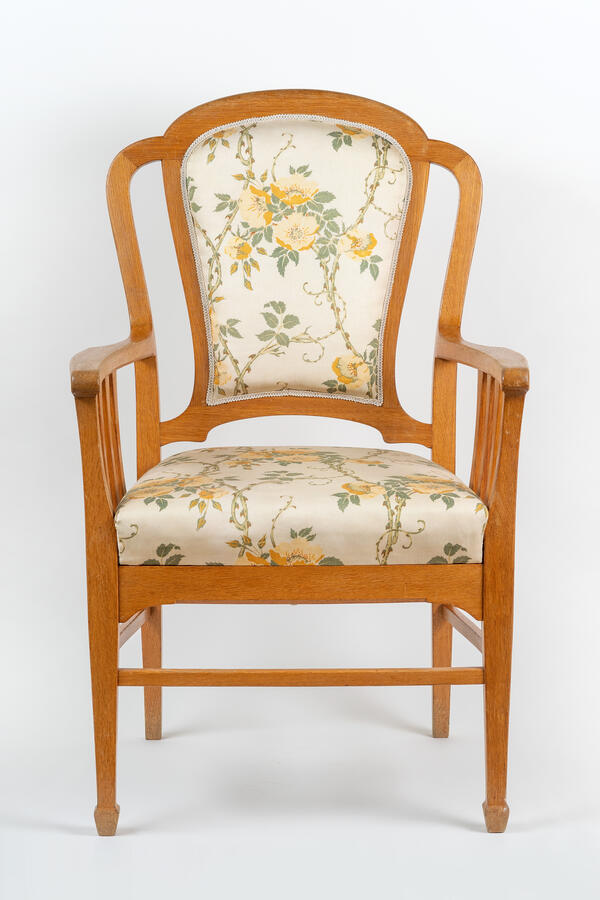After the conversion of the Concert Hall in 1902, the imperial quarters, which occupied the first and second floors of the east wing of the Alexander Palace, was enlarged by 20 rooms. By that time there were already four daughters in the family of Emperor Nicholas II, so the expansion of the children’s quarters was necessary.
The armchairs displayed are part of a set of seating furniture for the Playroom, consisting of 4 armchairs and 10 chairs in light oak and upholstered in a fabric with a printed pattern of bunches of yellow roses. The set was made in 1902 at St. Petersburg’s Friedrich Melzer furniture factory. The Playroom occupied the largest room in the children’s quarters. It had a corner of nursery and toy furniture, including a gilded chair with a music box.
When Tsesarevich Alexei was born in 1904, his toys started to appear in the Playroom: a rack of children’s rifles, the armor of a medieval knight, Indian gear (a teepee, two pirogues, bows, a headdress), models of a four-piper, a hospital van, a machine gun, a cannon, etc. Models of airplanes hung from the ceiling. At Christmas time there was a Christmas tree for children in the Playroom.
After the departure of the imperial family for exile in Tobolsk in 1917, a card catalogue was prepared, describing all furniture items from the Alexander Palace. The rooms of Nicholas II’s children were photographed and plans of the furniture arrangement were made. In the summer of 1918, the articles of furniture in the Children’s Rooms of the Alexander Palace were supposed to be handed over to juvenile labor colonies following a decision by the Commissar Alexander Lunacharsky and his wife. The latter headed the “Committee for Children’s Colonies”, to set up an orphanage in the palace.
In 1919–1920, museum officials checked the mansions of Detskoe (previously Tsarskoe) Selo occupied by juvenile labor colonies and returned the items from the palace to the museum’s collection. In 1929, on the instructions of the Institute of Scientific Pedagogy, the Children’s Rooms became an independent exhibition entitled “Class-based Upbringing in Tsarist Russia”. In June 1930, a commission appointed to determine the fate of the Children’s Rooms of the Alexander Palace decided to permanently close the exhibition and transfer the items to various organizations and museums. In 2017, three chairs from the Playroom of the Alexander Palace returned to the museum collection.
The armchairs displayed are part of a set of seating furniture for the Playroom, consisting of 4 armchairs and 10 chairs in light oak and upholstered in a fabric with a printed pattern of bunches of yellow roses. The set was made in 1902 at St. Petersburg’s Friedrich Melzer furniture factory. The Playroom occupied the largest room in the children’s quarters. It had a corner of nursery and toy furniture, including a gilded chair with a music box.
When Tsesarevich Alexei was born in 1904, his toys started to appear in the Playroom: a rack of children’s rifles, the armor of a medieval knight, Indian gear (a teepee, two pirogues, bows, a headdress), models of a four-piper, a hospital van, a machine gun, a cannon, etc. Models of airplanes hung from the ceiling. At Christmas time there was a Christmas tree for children in the Playroom.
After the departure of the imperial family for exile in Tobolsk in 1917, a card catalogue was prepared, describing all furniture items from the Alexander Palace. The rooms of Nicholas II’s children were photographed and plans of the furniture arrangement were made. In the summer of 1918, the articles of furniture in the Children’s Rooms of the Alexander Palace were supposed to be handed over to juvenile labor colonies following a decision by the Commissar Alexander Lunacharsky and his wife. The latter headed the “Committee for Children’s Colonies”, to set up an orphanage in the palace.
In 1919–1920, museum officials checked the mansions of Detskoe (previously Tsarskoe) Selo occupied by juvenile labor colonies and returned the items from the palace to the museum’s collection. In 1929, on the instructions of the Institute of Scientific Pedagogy, the Children’s Rooms became an independent exhibition entitled “Class-based Upbringing in Tsarist Russia”. In June 1930, a commission appointed to determine the fate of the Children’s Rooms of the Alexander Palace decided to permanently close the exhibition and transfer the items to various organizations and museums. In 2017, three chairs from the Playroom of the Alexander Palace returned to the museum collection.




